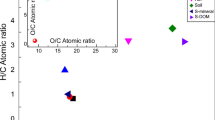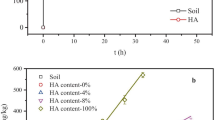Abstract
The mechanisms of association of hydrophobic organic contaminants with natural organic matter (for example humic acid, HA) in soil and sediment are a major objective of environmental and geochemical research. This paper discusses a general model for studying the process of association between a series of rodenticides and humic acid, by use of a C18 stationary phase. An approach based on extended Langmuir distribution isotherms was used to study the effect of bulk solvent pH and ionic strength (adjusted by addition of sodium cation) on the mechanism of HA–rodenticide binding. The results demonstrated that: (i) HA can be adsorbed on the surface of the C18 phase; (ii) the rodenticides can be associated with HA adsorbed on the C18 surface; and (iii) ionic strength and bulk solvent pH both modify the conformation of HA and thus its mechanism of association with the rodenticide molecules.
Similar content being viewed by others
References
André C, Guillaume YC (2004) Chromatographia 59:429
Thurman EM (1985) Organic geochemistry of natural waters. Martinus Nijhoff/Junk, Dordrecht
Stevenson FJ (1994) Humus chemistry; genesis, composition, reactions. Wiley, New York
Sposito G (1984) The surface chemistry of soil, Oxford University Press, New York
Murphy EM, Zachara JM, Smith SC (1990) Environ Sci Technol 24:1507
Gu B, Schmitt J, Chen Z, Liang L, McCarthy JF (1994) Environ Sci Technol 28:38
Snenesi N (1993) Organic pollutant migration in soil as affected by soil organic matter. Molecular and mechanistic aspects. In: Petruzzelli D, Helfferich FG (eds) Migration and fate of pollutants in soils and subsoils. NATO-ASI Series, vol G32, Springer, Berlin
Tomlin C (2001) The pesticide manual. British Crop Protection Council, 20 Bridport Road, Thornton Heath, UK
WHO (1995) Environmental heath criteria: anticoagulant rodenticide. WHO, Geneva
Nighoghossian N, Ruel JH, French P, Froment JC, Trouillas P (1999) Rev Neurol 146:221
Van Sittert NJ, Tuinman CP (1991) Toxicology 94:71
Kruse JA, Carlson RW (1992) Ann Emerg Med 21:331
Watterson AE, Thomas HF (1992) Public Health 106:473
Hui CH, Lie A, Lam CK, Bourke C (1996) Forensic Sci Int 78:13
Parsons BJ, Day LM, Ozanne-Smith J, Dobbin M, (1996) Aust NZ J Public Health 20:488
WHO (1995) Heath and safety guide: bromadiolone. WHO, Geneva
Thijssen HHW, Baars LGM, Vervoort-Peters HTM (1998) J Pharmacol 95:675
Thijssen HHW, Baars LGM (1989) Biochem Pharmacol 38:1115
Fasco MJ, Principe LM (1982) J Biol Chem 257:4894
Lee SK, Freitag D, Kettrup A, Kim YH (1993) Water Res 27:199
Duan J, Wilson F, Graham N, Tay JH (2002) Desalination 151:53
Li F, Yuasa A, Ebie K, Azuma Y, Hagishita T, Matsui Y (2002) Water Res 36:4592
Hur J, Schlautman MA (2005) J Colloid Interface Sci, in press
Warwick P, Hall A, Pashley V, Bryan N (2001) Chemosphere 45:303
Heuer C, Kusters E, Plattner T, Seidel-Morgenstern A (1998) J Chromatogr A 827:175
Blummel C, Hugo P, Seidel-Morgenstern A (1999) J Chromatogr A 865:51
Jandera P, Buncekova S, Mihlbachler K, Guiochon G, Backvoska V, Planeta J (2001) J Chromatogr A 925:19
André C, Jacquot Y, Truong TT, Thomassin M, Robert JF, Guillaume YC (2003) J Chromatogr B 796:267
Bevington PR (1969) Data reduction and error analysis for the physical sciences. McGraw–Hill, New York
Janado M, Yano Y, Umara M, Kondo Y (1995) J Solution Chem 24:287
McDevit WF, Long FA (1952) J Am Chem Soc 74:1773
Dack MR (1975) J Chem Soc Rev 4:211
Cameron RS, Thornton BK, Swift RS, Posner AM (1972) J Soil Sci 23:394
Ghosh K, Schnitzer M (1980) Soil Sci 129(5):266
Melander W, Campbell DE, Horvath C (1978) J Chromatogr 158:215
Ranatunga R, Vitha M, Carr PW (2002) J Chromatogr A 946:47
Li J, Carr PW (1994) J Chromatogr A 670:105
Author information
Authors and Affiliations
Corresponding author
Rights and permissions
About this article
Cite this article
André, C., Truong, T., Xicluna, A. et al. Effect of pH and Ionic Strength on the Mechanism of Association of Rodenticides with Natural Organic Components of Soil. Chroma 61, 225–230 (2005). https://doi.org/10.1365/s10337-005-0503-1
Received:
Revised:
Accepted:
Published:
Issue Date:
DOI: https://doi.org/10.1365/s10337-005-0503-1




